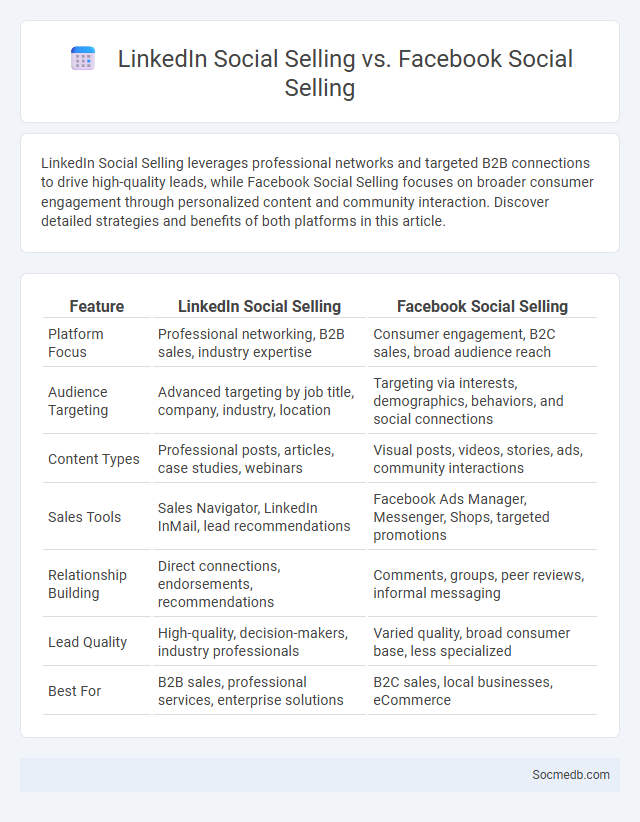
Photo illustration: LinkedIn Social Selling vs Facebook Social Selling
LinkedIn Social Selling leverages professional networks and targeted B2B connections to drive high-quality leads, while Facebook Social Selling focuses on broader consumer engagement through personalized content and community interaction. Discover detailed strategies and benefits of both platforms in this article.
Table of Comparison
| Feature | LinkedIn Social Selling | Facebook Social Selling |
|---|---|---|
| Platform Focus | Professional networking, B2B sales, industry expertise | Consumer engagement, B2C sales, broad audience reach |
| Audience Targeting | Advanced targeting by job title, company, industry, location | Targeting via interests, demographics, behaviors, and social connections |
| Content Types | Professional posts, articles, case studies, webinars | Visual posts, videos, stories, ads, community interactions |
| Sales Tools | Sales Navigator, LinkedIn InMail, lead recommendations | Facebook Ads Manager, Messenger, Shops, targeted promotions |
| Relationship Building | Direct connections, endorsements, recommendations | Comments, groups, peer reviews, informal messaging |
| Lead Quality | High-quality, decision-makers, industry professionals | Varied quality, broad consumer base, less specialized |
| Best For | B2B sales, professional services, enterprise solutions | B2C sales, local businesses, eCommerce |
Introduction to Social Selling
Social selling leverages social media platforms like LinkedIn, Twitter, and Facebook to engage with potential customers and build relationships that drive sales. It involves sharing valuable content, participating in industry conversations, and using social listening tools to identify prospects' needs. Effective social selling increases brand visibility, nurtures trust, and shortens the sales cycle by aligning social interactions with the buyer's journey.
Defining LinkedIn Social Selling
LinkedIn Social Selling leverages the platform's extensive professional network to foster relationships and drive sales through meaningful engagement. By utilizing LinkedIn's tools such as Sales Navigator, users identify prospects, share relevant content, and build trust with targeted decision-makers. This strategy enhances lead generation and accelerates the sales cycle by positioning sales professionals as industry experts within their niche.
Understanding Facebook Social Selling
Facebook social selling leverages the platform's vast user base of over 2.9 billion monthly active users to build authentic relationships and drive sales through personalized interactions and content sharing. Utilizing Facebook's robust targeting tools, businesses can identify and engage potential customers by analyzing behavior, interests, and demographics to tailor messaging effectively. The integration of Facebook Shops and Messenger enables seamless transactions and customer support, enhancing the buyer journey and increasing conversion rates.
Core Differences: LinkedIn vs Facebook Social Selling
LinkedIn focuses on professional networking and B2B social selling, leveraging detailed user profiles and industry-specific content to connect decision-makers and facilitate trust-based relationships. Facebook emphasizes B2C interactions with broad audience reach, casual engagement, and visually rich advertising options tailored for brand awareness and direct consumer sales. The core difference lies in LinkedIn's targeted, relationship-driven approach versus Facebook's expansive, mass-market strategy for social selling.
Audience Targeting Strategies on LinkedIn
Effective audience targeting strategies on LinkedIn leverage advanced filters such as industry, job title, company size, and geographic location to reach your ideal professional connections. Utilizing LinkedIn's Matched Audiences feature enables precise retargeting of website visitors, existing contacts, and account-based marketing efforts. Tailoring your content and ads to specific decision-makers within your target sectors increases engagement and conversion rates significantly.
Audience Targeting Strategies on Facebook
Facebook's Audience Targeting Strategies enable precise segmentation using demographic data, interests, and behaviors to reach Your ideal customers effectively. Custom Audiences allow retargeting existing users, while Lookalike Audiences expand reach by finding profiles similar to Your best customers. Leveraging these tools improves engagement, boosts conversions, and maximizes ad spend efficiency on Facebook's platform.
Content Approaches: Professional vs Personal Tone
Professional tone in social media content enhances brand credibility by using clear, concise language and industry-specific terminology tailored to target audiences. Personal tone fosters authentic connections through informal language, storytelling, and emotional appeal, increasing engagement and relatability. Choosing between these approaches depends on brand identity, audience demographics, and campaign objectives.
Measuring Social Selling Success on Both Platforms
Measuring social selling success on platforms like LinkedIn and Instagram relies on tracking engagement metrics such as click-through rates, conversion rates, and follower growth. You can assess your campaign's effectiveness by analyzing data like lead generation statistics, response times, and customer interactions to optimize strategies. Leveraging platform-specific analytics tools helps ensure your social selling efforts yield tangible business results.
Choosing the Right Social Selling Platform for Your Goals
Selecting the ideal social selling platform depends on your target audience, product type, and business objectives. LinkedIn excels for B2B connections and professional networking, while Instagram and Facebook offer robust options for engaging visual content and direct consumer sales. Analyzing platform demographics, engagement rates, and e-commerce features ensures alignment with your brand's social selling strategy and maximizes conversion potential.
Future Trends in Social Selling
Future trends in social selling emphasize the integration of AI-driven personalization and immersive technologies like augmented reality to enhance customer interactions and buying experiences. Businesses are leveraging data analytics to predict consumer behavior and tailor content, making social media platforms pivotal sales channels. Your ability to adapt to these innovations will determine success in reaching and engaging increasingly savvy digital shoppers.
 socmedb.com
socmedb.com